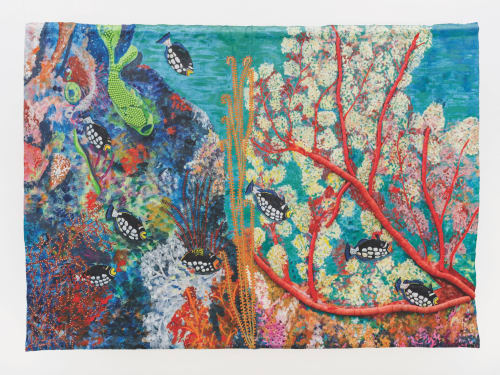Inspired by scuba dives off the Philippine coast, Abad paints an underwater world at once wild and interdependent
In the darkened gallery, seven monumental padded canvases hang from the ceiling. Lit from below, their undulating surfaces present vibrant aquatic scenes made from paint, fabric and other decorative objects. In Sepoc Wall (1985), the sinuous zigzags of Rickrack braiding become strands of seaweed, pearlescent buttons tiny bubbles. Fish eyes glitter with shisha (mirror-work) in Anilao at its Best (1986), while soft bas-relief passages evoke thick stalks of coral in Dumaguete’s Underwater Garden (1987). On the reverse of the paintings, constellations of stitches evince the skill of an inveterate craftswoman, punctuated by the artist’s handwritten notes, including meticulous lists of materials: embroidered broken glass, lace, rhinestones.
Over her 32-year career, Philippine-American artist Abad produced more than 5,000 works informed by her travels to more than 60 countries, employing a social-realist approach to depict the experiences of immigrants, refugees and others who made a life on the margins. During the 1980s, a time when Minimalism and Conceptualism dominated in the West, Abad dived in the opposite direction. Making a name for herself as an artworld ‘bad girl’, she revelled in scrappy, expressive markmaking, dense bricolage, a wide range of crafts— Indonesian batik, Malian mud cloth and Pakistani ralli quilts, to name but a few —and exuberant figuration, creating stitched and padded textile paintings she termed trapuntos.
Densely embellished and colourful, the seven trapuntos that, along with two acrylic paintings, comprise Underwater Wilderness were begun in 1985. Inspired by Abad’s scuba dives off the coast of the Philippines during the 1980s, they were first exhibited in an immersive installation, Assaulting the Deep Sea, in 1986 at the Ayala Museum in Manila, the same year the People Power Revolution brought Ferdinand Marcos’s 20-year dictatorship to an end. For Abad, who led student protests of the Marcos regime before she was forced to flee the country, the exhibition in the capital marked a homecoming of sorts. She arranged the works in a playful, transportive setting replete with humble materials and found objects. The paintings hung like backdrops as visitors walked on floors lined with nets and navigated between cloth squids and coralline garlands. Abad walked around the exhibition opening in a bikini and diving gear.
Underwater Wilderness dovetails with a major travelling retrospective that aims to reevaluate the artist’s legacy. While it’s natural to wonder what Abad, who died in 2004, might have made of the more traditional white-cube presentation of her work, this simplified installation of her diving paintings allows their astounding formal complexity to come to the fore. Dumaguete’s Underwater Garden, which stretches three metres across the back wall of the gallery, exemplifies the artist’s expert evocation of the play of water and light. The dry matt of Abad’s oil and acrylic might seem a counterintuitive approach to rendering a wet landscape, but it provides ideal contrast to the glitter, gold thread and sequin accents that capture the sun’s rays hitting the reef and plant life.
Seen today, Abad’s approaches appear clearly in kinship with the feminist strategies of claiming space used by other women artists during the 1970s and 80s: from working at larger-than-life scale and colour, as with Niki de Saint Phalle, to adopting a provocative persona to disrupt the elitism and exclusivity of mainstream art spaces like Lorraine O’Grady, or repositioning women-led textile and sewing traditions as fine art, as did Faith Ringgold(who was one of Abad’s admirers).
In her 1986 artist statement on her Underwater Wilderness works, Abad said that when she went diving, she felt ‘like an infidel intruding into somewhere sacred’. To stand before Sepoc Wall is to be engulfed nearly floor to ceiling in one such hallowed spot under the sea. Varied brushwork, from impressionistic strokes to geometric tessellations, reveals a thriving network of heterogeneous aquatic life, punctuated by a glowing green umbrellalike shape, which hovers at the top of the densely patterned composition. Through collage and a melding of styles, Abad paints an underwater world at once wild and interdependent. Her framing of the diver as an intruder to an existing ecosystem worthy of reverence echoes throughout the exhibition, where hybrid objects interweave elements of craft with gravity and contagious awe.
— Chantal McStay


